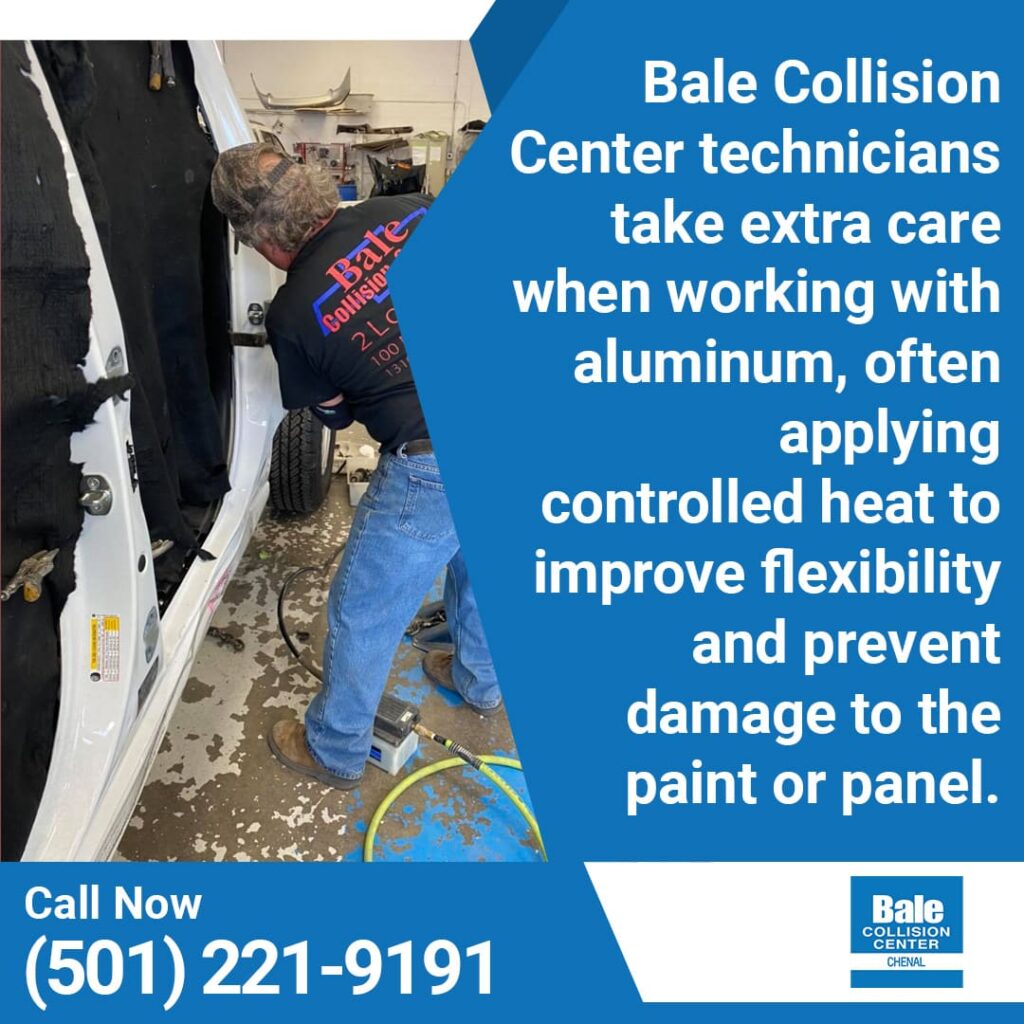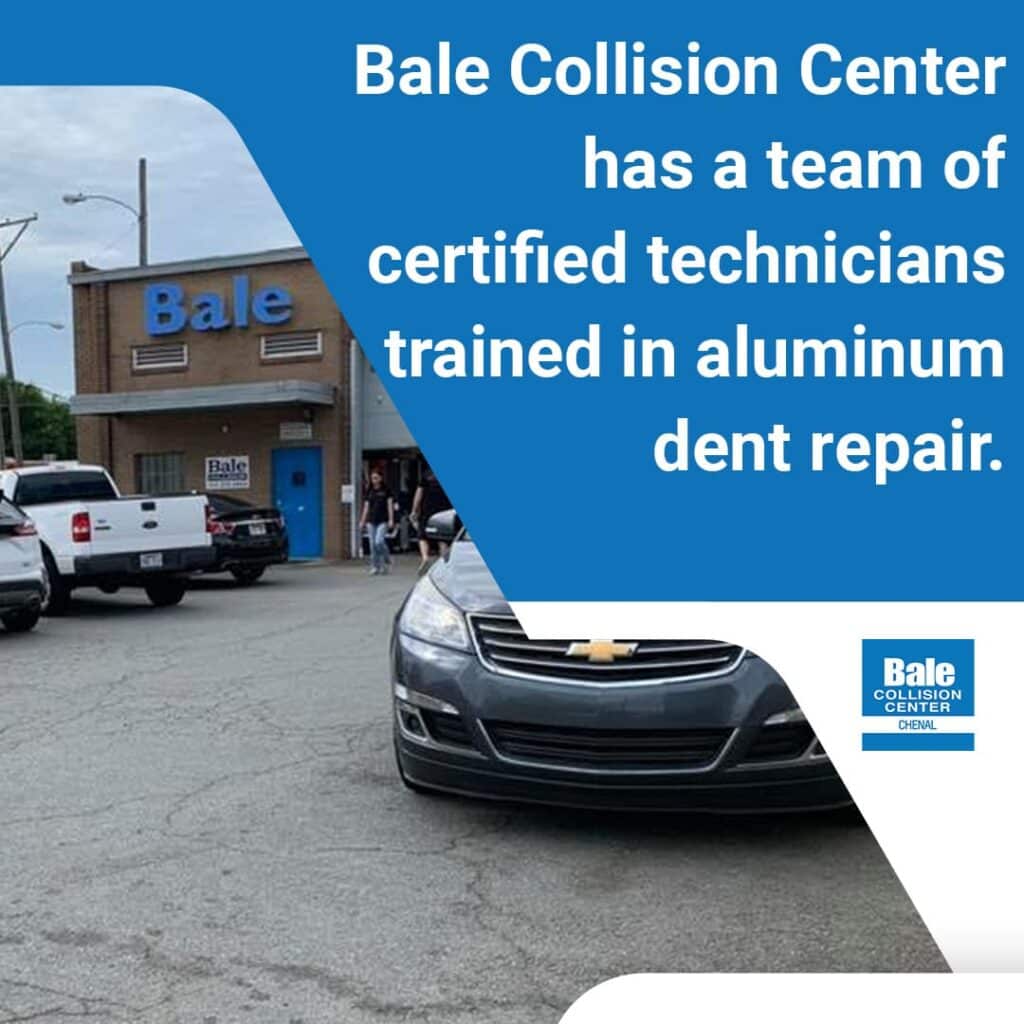Yes, paintless dent repair (PDR) can fix dents on aluminum panels, but it requires special tools and training. Unlike steel, aluminum behaves differently under pressure. It doesn’t retain shape as easily and is more resistant to being reshaped. That’s why not every dent can be repaired using the same approach.
This article explains how we use paintless dent repair on aluminum panels, when it works best, and how our trained technicians handle aluminum body damage at Bale Collision Center in Little Rock. We’ll help you understand what to expect from a qualified paintless dent repair shop and how to know if this method is the right choice for your vehicle.

The Unique Challenges of Aluminum Panels
Before exploring why aluminum can be more challenging to repair, it is helpful to understand how paintless dent repair (PDR) works. Paintless dent repair (PDR) is a non-invasive method that removes minor dents without the need for sanding, fillers, or repainting. Specialized tools are used to access the back of a dent and gently massage the metal back into place. This method preserves the factory paint and helps retain vehicle value. PDR is commonly used for repairing hail damage, door dings, and minor creases where paint is not cracked or chipped.
At Bale Collision Center, we utilize calibrated tools and panel-specific access methods tailored to each make and model for performing paintless dent repair in Little Rock.
What Makes Aluminum Panels Different?
Aluminum panelsare more rigid and less elastic than steel, which makes paintless dent repair more difficult and time-consuming. Aluminum doesn’t “remember” its shape like steel does. This means technicians must apply more controlled force and work more slowly to avoid over-stretching or cracking the panel. PDR on aluminum often requires heat and frequent rechecking to track panel movement.
For example, a dent on a Ford F-150’s aluminum hood will not respond the same way as a dent on a steel Chevy Silverado panel. The tools might be similar, but the material demands different repair pressures and techniques.
How Does Aluminum Compare to Steel in Repairs?
Compared to steel, aluminum is lighter and less forgiving during reshaping.
Elasticity: Steel flexes more easily. Aluminum resists reshaping, so it springs back less and can crack if overworked.
Thickness: Aluminum is typically thinner than steel, but it is not as strong. Therefore, the panels are made thicker to match the strength of steel. They’re engineered for weight reduction, not flexibility.
Strength: Aluminum has high tensile strength, but that doesn’t help with dent repair; it just makes reshaping slower.
Technicians at a paintless dent repair shop adjust the technique based on the panel’s metal type. This is why PDR on aluminum costs more and takes longer.
How Does Aluminum Respond to Pressure During Repairs?
Aluminum spreads pressure more widely across the surface, making dents harder to isolate and reshape. This property makes it difficult to focus force in a small area without causing surface warping or paint damage. That’s why skilled technicians often use a combination of indirect pushing and soft-tap tools.
A common example is hail damage. On aluminum roofs or hoods, each dent may take longer to repair than a similar dent on steel. This isn’t due to the technician’s skill, but the metal’s nature. By understanding these differences, car owners looking for paintless dent repair near you can better judge the time, cost, and process involved. At Bale Collision Center, we evaluate each dent based on its size, location, and panel material before recommending PDR.
What Are the Risks of Stretching or Cracking Aluminum?
Applying too much force during aluminum dent repair can cause the panel to stretch or crack. Aluminum has low elasticity. If technicians push too hard or heat the area too much, the metal won’t return to its shape. It may warp or break instead. This is common on sharp dents or near panel edges, where the material is already under stress.
Once a crack appears, PDR is no longer an option. The panel will need filler, sanding, or replacement. That’s why trained technicians at a paintless dent repair shop take extra care when handling aluminum. This careful process keeps the panel intact, and the paint stays unbroken. For drivers looking for paintless dent repair near you, technician experience plays a major role in getting the repair done right.
PDR for aluminum demands more than just tools—it requires a clear understanding of how the metal behaves under pressure. Paintless dent repair shops must adjust their techniques to avoid stretching, cracking, or worsening the damage.
How Technicians Perform PDR on Aluminum
Specialized Tools for Aluminum Repair
Technicians use tools designed specifically for aluminum, which differ from those used on steel panels. Aluminum requires softer, more precise tools to prevent damage to the metal or paint. Steel tools are often harder and can leave marks or stretch aluminum if used incorrectly. For example, plastic or nylon tips and flexible rods help technicians carefully push out dents without creating new damage.
Access points also play a bigger role with aluminum panels. Because aluminum is less flexible, technicians need to reach behind the dent more precisely to apply the right pressure. This often means removing interior panels or trim for better access. At Bale Collision Center, our experienced technicians know how to navigate these challenges to protect your vehicle.
Use of Heat and Controlled Techniques
Controlled heat is sometimes applied during aluminum dent repair to soften the metal, making it easier to reshape. Applying low heat carefully increases aluminum’s flexibility. This reduces the chance of cracking or stretching the panel during the repair process. Heat also minimizes stress on the paint, preserving the factory finish.
However, overheating can cause paint damage or metal warping, so technicians must apply heat precisely and monitor the temperature. This controlled approach is part of what sets experienced paintless dent repair shops apart.
At Bale Collision Center, our technicians use controlled heat and specialized tools to repair aluminum dents while preserving the original paint finish.
Is PDR Always Suitable for Aluminum Dents?
Conditions That Make a Dent Repairable
Paintless dent repair works best on aluminum dents when the paint is intact and the dent is small to medium in size. If the paint shows no cracks or chips, technicians can carefully push out the dent without affecting the finish. Dents that are shallow and located on flat or slightly curved panels are easier to access and repair.
Access to the back of the panel is also important. If technicians can reach behind the dent to apply pressure, the repair is usually possible. For example, dents on doors, hoods, or fenders that allow panel removal or access behind them are good candidates for PDR.
When Other Methods May Be Needed
PDR may not be suitable if the paint is cracked or the dent is near panel edges, seams, or structural parts of the vehicle. Cracked or chipped paint often requires traditional bodywork and repainting to prevent rust and restore appearance. Dents on panel edges or where panels join can be difficult to access and may not respond well to PDR tools. PDR cannot fix structural damage to the vehicle’s frame or support parts. In such cases, more extensive repair methods are necessary to restore safety and function.
At Bale Collision Center, our technicians carefully evaluate each dent to recommend the best repair method. The clear evaluation process helps customers with reliable paintless dent repair in Little Rock suited to their aluminum vehicle’s condition.
Benefits of Using PDR on Aluminum Panels
Maintains Original Paint Finish
Paintless dent repair preserves the vehicle’s original paint finish, avoiding the need for repainting. Since PDR works by carefully massaging the dent out without disturbing the paint, there is no risk of mismatched colors or paint texture differences. This is important for aluminum panels, where repainting can be more complicated and costly due to the metal’s properties.
Shorter Repair Times
PDR typically takes less time than traditional bodywork, allowing faster vehicle turnaround. Because it avoids sanding, filling, and repainting, PDR repairs on aluminum panels can often be completed quickly. This fast service benefits drivers who need to get back on the road sooner while reducing labor costs at the paintless dent repair shop.
Lower Repair Cost Compared to Repainting
Paintless dent repair generally costs less than conventional repairs involving repainting or panel replacement. Avoiding paint and body filler saves material costs. Also, shorter labor hours keep the overall expense down. For aluminum vehicles, which require special paint and more complex processes when repainted, the savings with PDR are often more noticeable.
Environmentally Safer Process
PDR is an eco-friendly option because it produces no paint waste or chemical runoff. Traditional body repairs generate fumes from paint, solvents, and fillers, which require special handling and ventilation. PDR uses no harsh chemicals, reducing environmental impact. This makes it a preferred choice for those seeking environmentally conscious repair options.
At Bale Collision Center, our experts provide paintless dent repair in Little Rock that combines quality, speed, and cost efficiency.

Bale Collision Center for Paintless Dent Repair in Little Rock
Certified Technicians
At Bale Collision Center, our certified technicians are specially trained in aluminum panel repairs. Since aluminum differs from steel, it requires specific skills and techniques distinct from those used for steel. Our team stays up-to-date on the latest repair methods to handle dents precisely without damaging the paint or panel integrity. This expertise provides reliable results for those seeking paintless dent repair near you.
Equipped for Both Steel and Aluminum Panel Repairs
Our shop is fully equipped to repair both steel and aluminum panels using paintless dent repair techniques. Having the right tools and technology allows us to work on various vehicle makes and models. This flexibility makes Bale Collision Center a trusted paintless dent repair shop regardless of panel material.
Support with Insurance and Repair Estimates
We assist customers with insurance claims and provide accurate repair estimates for paintless dent repair in Little Rock. Bale Collision Center assists by communicating directly with insurance companies. We offer transparent pricing so you know the costs upfront, making your repair experience straightforward and stress-free.
For those searching for paintless dent repair near you, Bale Collision Center delivers expert service tailored to aluminum panels and customer needs.
Trusted Paintless Dent Repair in Little Rock
At Bale Collision Center, we use paintless dent repair to fix dents on aluminum panels without disturbing the original paint or structure. Aluminum can be harder to work with than steel, but our team has the training and tools to handle it. We use precise techniques that allow us to restore panels without the need for sanding, fillers, or repainting. That means quicker turnaround times and lower costs for you.
We’ve equipped our shop to handle both steel and aluminum repairs, and we work directly with your insurance to keep the process smooth. Choosing paintless dent repair protects your vehicle’s value while cutting down on material waste and emissions.
Trust Bale Collision Center in Little Rock for expert paintless dent repair on aluminum panels. Our skilled technicians are ready to restore your vehicle’s appearance quickly and efficiently. Contact us today at (501) 221-9191 or email bccwlr@baleautomotive.com to schedule your repair or request a free estimate.
